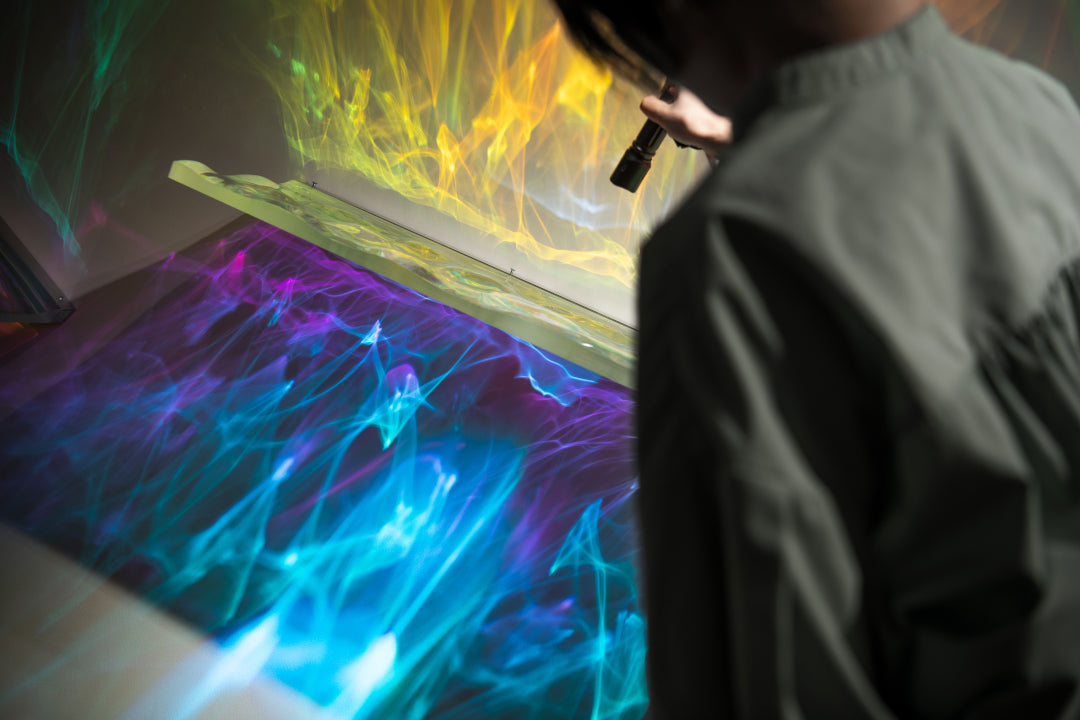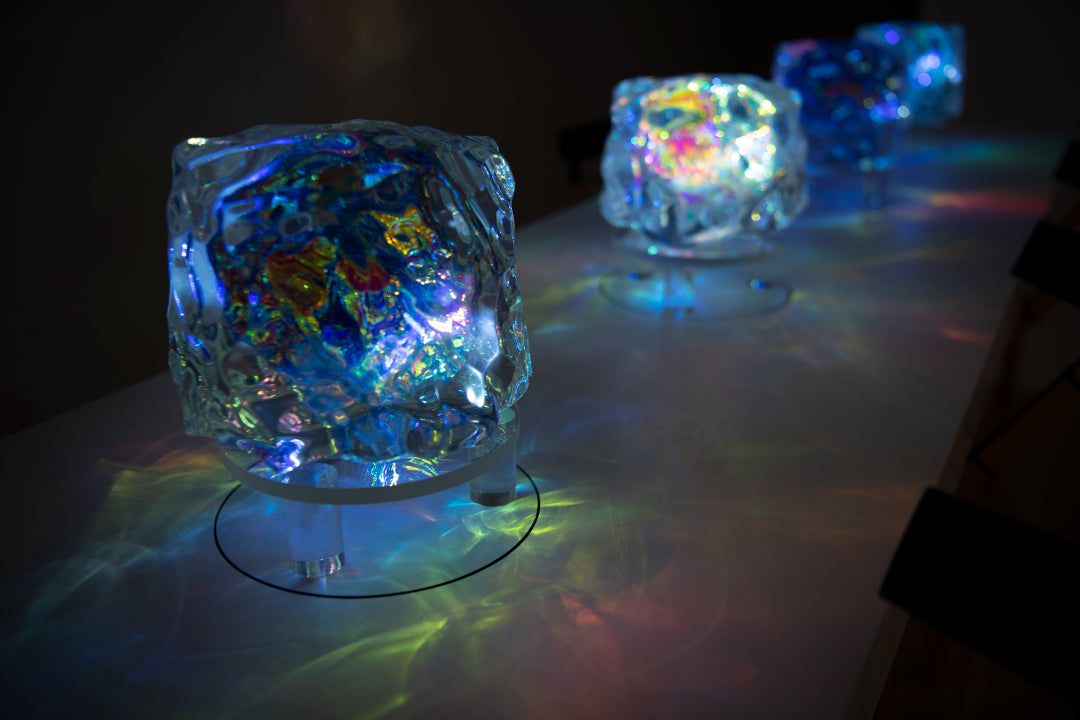ARTICLES
Hidden Beneath a Beautiful Facade | Go Ogawa Solo Exhibition “Surreal Prism―Intangible Entity”
October 13, 2022
Ginza, Japan

A prism shining in brilliant colors. A myriad of lights like flames covering the space. Go Ogawa's solo exhibition, “Surreal Prism―Intangible Entity,” held at Whitestone Gallery Ginza New Gallery dazzles viewers with carefully selected media. We interviewed the artist about the hidden themes behind his beautiful shining works, his reasons in becoming an artist, and his creative activities in depth.
Refracted Lights that Show “Fiction and Reality”

Go Ogawa, Nebula prism, 2022, H65×W65×D6cm, acrylic, special film, wood
―The main work in the exhibition, “Nebula prism”, is a very special series in which the color of the work changes depending on the viewing angle and lighting. Could you tell us what you envisioned?
Ogawa: In the “Nebula prism” series, I was able to create a work that was close to an ideal that I had envisioned of the galaxy. By incorporating the phenomenon of colors changing depending on the viewing angle, it allows the audiences to experience a pseudo-perception in the gaps that occur in everyday life.
―“Nebula prism” series also supplies another viewing experience, in which a different aspect appears when a black light is used. What are the intentions?
Ogawa: The heart of this series is based on “falsified imagery versus reality” meaning that the source of beauty is not necessarily beautiful.
The “mold” emerges when you expose it to the black light. The part of the work seen under ordinary lighting reveals the image of a galaxy, however, another side lies a vast number of microorganisms. This particular work allows the viewer to uncover different facades to the galaxy interactively with their own hands.

“Surreal Prism―Intangible Entity”, exhibition view
A Surreal Light Experience Weaved by a Hyperspace World.
― Can you please share with us what the word “surreal” means to you?
Ogawa: I think it's a phenomenon that occurs unconsciously and cannot be perceived by humans. If we translate this into artistic terms, the act of deciphering the essential hierarchy itself could be described as “surreal,” rather than superficial differences.

“Surreal Prism―Intangible Entity”, exhibition view
―In the current exhibition, you made new attempts using intelligent lighting and changing our visual perception by incorporating black lights and so on.
Ogawa: It's been a long time since my last solo exhibition in Tokyo. Therefore, I decided to take it a step further than usual at this exhibition by showing all the techniques and skills that I’ve accumulated over the past few years.
Until now, I wasn't particular about lighting due to technical limitations, but ever since MinebeaMitsumi released their new lighting, it opened new doors to experimenting with intelligent lighting. I'm excited to see the outcome.

“Surreal Prism―Intangible Entity”, exhibition view
―The 2nd floor of Whitestone Gallery Ginza New Gallery has been beautifully transformed into a rare sight at the gallery space.
Ogawa: The 2nd floor has always been a rather calm-looking space, but this time, my plan was to exhibit a lively installation. I had many opportunities to do installations at events, but I’m unable to actually foresee the outcome until the actual day. There’s definitely a sense of anxiety and pressure every time but it's a satisfying process to see the end results.
―After this exhibition, what kind of challenge is next?
Ogawa: Someday in the future, I wish to exhibit my work in outer space, or create a work that can be seen from outer space.

“Surreal Prism―Intangible Entity”, exhibition view
What Go Ogawa Seeks: Art and Entertainment
―What are the reasons you became an artist?
Ogawa: I aim to create works that transcend the three dimensions, and to fascinate viewers beyond the three dimensions.
Therefore I try to do as little as possible in figurative works. I'm particular about the surface composition and I don’t work on a composition as a whole. Whether the formative quality is good or bad, it is not within my scope of production.
―Are there any artists who inspired you?
Ogawa: There are three: Olafur Eliasson, Tokujin Yoshioka, and Jeppe HEIN. What they have in common is the reconstruction of phenomena and a playful spirit in exploration. Thanks to them, they helped inspire me to pursue a career as an artist. I first discovered their works and visited their exhibitions in graduate school. They’re a source of inspiration that I’d like to become and surpass.

Go Ogawa talks about his influences and works.
―What is your source of inspiration?
Ogawa: Hayao Miyazaki and Isao Takahata, who are best known for their Ghibli films. My current interest is art and entertainment, and while both directors find themselves categorized in the genre of commercial animation, their artistic vision is distinctly inherent in all of their works. I admire the overwhelming artistic expression that both directors produce and I also awed by the fact that they have been producing films for many years.

“On Your Mark” that Ogawa says is the most favorite. © 1995 Studio Ghibli
Works Born Through Experiments of Trial and Error
―What does your daily creation process look like?
Ogawa: It’s a constant process of experimentation of trial and errors. I carry out a calm and zen like attitude which I believe leads to the creations that produce a spectrum of lights. The sense of transcendence that comes from polishing my craft is the ultimate core of production.

At artist's atelier
―Before 2014, most of your works were in soft pastel colors, but after 2015, the colors have become clearer and more vivid. Various vivid colors stand out in this exhibition as well. How do you decide which color and tone to use?
Ogawa: Frankly speaking, I'm not particular about colors.
I aim to maximize the characteristics of the special film (hologram sheet) that I use and to work in a way that no one has ever done before. For that reason, I experiment with the combination of three-layered film, transparent material, and surface shape, which is then converted into works of art from the data I accumulated.
Since I am also working on a daily basis without knowing how the complete work will turn out, I view my works as prototypes.

At artist's atelier
―How do you decide which materials to use?
Ogawa: I mainly use chemical-based materials, so I conduct experiments to see if they are strong enough to be used as a work of art and adjust accordingly. Some materials are impossible to process as they depend on the temperature.Therefore, my operation has to change depending on the season. As some processes are possible only in the middle of winter, long-term planning is necessary.

“Phantom prism” series the production of which starts in the cold season. After casting the resin in the winter and letting it rest for several months, the cutting and polishing work begins.

“Surreal Prism―Intangible Entity”, exhibition view
In our interview, Ogawa states, “The source of falsified imagery and reality is a catalyst for my ‘anger’.” Though the driving force behind his works is from a negative emotion, Ogawa has transformed it into something visually beautiful concealed by an aurora of lights, and colors.
The works that conceal the artist’s intentions are hard to image judging from its vivid appearance. Go Ogawa’s solo exhibition “Surreal Prism―Intangible Entity” runs until Saturday, October 29th.
Click here for exhibition details. »